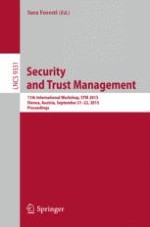This book constitutes the refereed proceedings of the 11th International Workshop on Security and Trust Management, STM 2015, held in Vienna, Austria, in September 2015, in conjunction with the 20th European Symposium Research in Computer Security, ESORICS 2015.
The 15 revised full papers were carefully reviewed and selected from 38 submissions. They are organized in topical sections as security metrics and classification; data protection; intrusion detection and software vulnerabilities; cryptographic protocols; controlling data release; and security analysis, risk management and usability.
